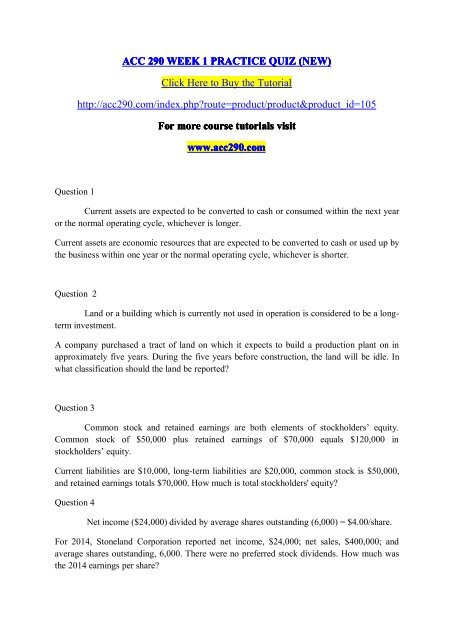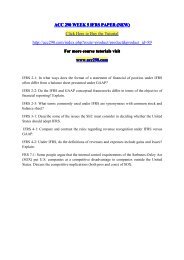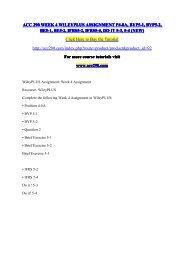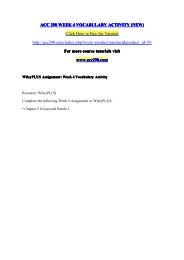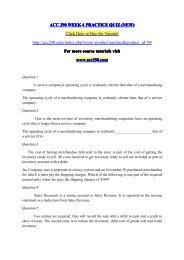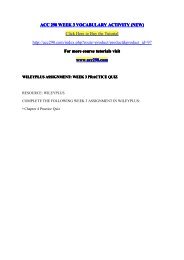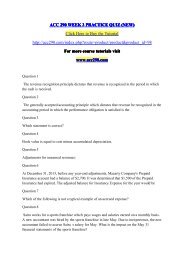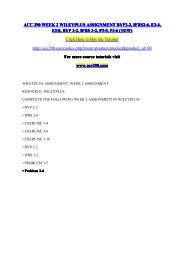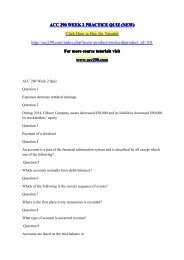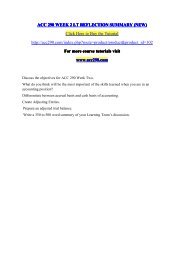ACC 290 WEEK 1 PRACTICE QUIZ (NEW) / acc290dotcom
For more course tutorials visit www.acc290.com Question 1 Current assets are expected to be converted to cash or consumed within the next year or the normal operating cycle, whichever is longer. Current assets are economic resources that are expected to be converted to cash or used up by the business within one year or the normal operating cycle, whichever is shorter.
For more course tutorials visit
www.acc290.com
Question 1
Current assets are expected to be converted to cash or consumed within the next year or the normal operating cycle, whichever is longer.
Current assets are economic resources that are expected to be converted to cash or used up by the business within one year or the normal operating cycle, whichever is shorter.
Create successful ePaper yourself
Turn your PDF publications into a flip-book with our unique Google optimized e-Paper software.
<strong>ACC</strong> <strong>290</strong> <strong>WEEK</strong> 1 <strong>PRACTICE</strong> <strong>QUIZ</strong> (<strong>NEW</strong>)<br />
Click Here to Buy the Tutorial<br />
http://acc<strong>290</strong>.com/index.php?route=product/product&product_id=105<br />
For more course tutorials visit<br />
www.acc<strong>290</strong>.<br />
acc<strong>290</strong>.com<br />
com<br />
Question 1<br />
Current assets are expected to be converted to cash or consumed within the next year<br />
or the normal operating cycle, whichever is longer.<br />
Current assets are economic resources that are expected to be converted to cash or used up by<br />
the business within one year or the normal operating cycle, whichever is shorter.<br />
Question 2<br />
Land or a building which is currently not used in operation is considered to be a longterm<br />
investment.<br />
A company purchased a tract of land on which it expects to build a production plant on in<br />
approximately five years. During the five years before construction, the land will be idle. In<br />
what classification should the land be reported?<br />
Question 3<br />
Common stock and retained earnings are both elements of stockholders’ equity.<br />
Common stock of $50,000 plus retained earnings of $70,000 equals $120,000 in<br />
stockholders’ equity.<br />
Current liabilities are $10,000, long-term liabilities are $20,000, common stock is $50,000,<br />
and retained earnings totals $70,000. How much is total stockholders' equity?<br />
Question 4<br />
Net income ($24,000) divided by average shares outstanding (6,000) = $4.00/share.<br />
For 2014, Stoneland Corporation reported net income, $24,000; net sales, $400,000; and<br />
average shares outstanding, 6,000. There were no preferred stock dividends. How much was<br />
the 2014 earnings per share?
Question 5<br />
The beginning balance of retained earnings is the ending balance minus net income<br />
plus dividends. Working backwards, $X + $402,000 - $34,000 = $2,184,000. Therefore,<br />
beginning retained earnings = $1,816,000.<br />
At December 31, 2014, Shorts Company had retained earnings of $2,184,000. During 2014,<br />
the company issued stock for $98,000, and paid dividends of $34,000. Net income for 2014<br />
was $402,000. How much was the retained earnings balance at the beginning of 2014?<br />
Question 6<br />
The current ratio measures liquidity and higher means the company is more liquid.<br />
The debt to assets ratio measures solvency and higher is not always better. We don’t know<br />
how many outstanding shares each company has so we cannot compare profitability.<br />
The following ratios are available for Leer Inc. and Stable Inc.<br />
Current Ratio Debt to Assets Ratio Earnings per Share<br />
Leer Inc. 2:1 75% $3.50<br />
Stable Inc. 1.5:1 40% $2.75<br />
Question 7<br />
Solvency ratios are good indicators of a company’s ability to survive over an<br />
extended period of time.<br />
Which of the following ratios measures the ability of the company to survive over a long<br />
period of time?<br />
Question 8<br />
Free cash flow can be used to pay dividends; acquire property, plant, and equipment;<br />
and pay off debts.<br />
Question 9<br />
Generally accepted accounting principles, or “GAAP” have substantial authoritative<br />
support, and are recognized as a general guide for financial reporting purposes.<br />
Question 10
Management can justify a new method of accounting if the financial information is<br />
more meaningful.


